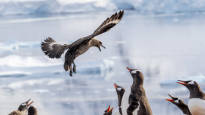According to the researchers, global warming caused violent snowstorms, which made nesting impossible for many bird species.
Queen Maud’s Land in Antarctica is home to the most important nesting sites for many seabirds. A year ago, the breeding season between December and January was a complete failure in the area, says science magazine Current Biology (you switch to another service).
Queen Maud’s land has two breeding areas: Svarthamare and Jutulsessen. In Antarctica, they are the most important nesting sites for the Antarctic plover, ice storm plover and snow storm plover.
Normally, they have up to hundreds of thousands of ice storm glider nests, as well as 2,000 snow storm glider nests and a couple hundred nests of wagtails.
In the 2021–22 breeding season, the researchers found a total of only three ice storm petrel nests and a few snow storm petrel nests, and no harrier nests.
These birds lay their eggs on exposed rock during the Antarctic summer. The researchers found that there were exceptionally strong snowstorms during the breeding season.
Climate change increases snowfall
According to the researchers, the reason behind the failure of nesting is global warming, which has also become evident in Antarctica in the last few years.
When the air warms by one degree, it can contain seven percent more moisture. For warmer zones, this leads to more heavy rainfall, but in arctic regions, snowfall increases.
As a result of this phenomenon, for example, Svarthamaren’s nesting area was covered in snow in January 2022, he says British Museum of Natural History (you will switch to another service).
– It was not just one single colony of birds that was hit by exceptional weather. We are talking about colonies that extend over hundreds of kilometers, says a researcher at the Norwegian Polar Institute Sebastien Deschamps of the Science Daily magazine (you will switch to another service) in the interview.
The harsh weather conditions in Antarctica always take away part of the chick production, but missing an entire generation of birds is very exceptional, according to researchers.
The liitäjä and kihu stocks are not threatened as a result of one year of cover.
– Seabirds are long-lived, and adult individuals are very durable. Each pair of birds has to produce offspring only a couple of times during their lifetime in order to maintain the size of the population, reminds the curator of the museum Alex Bond.
Birds can survive the roof year, but the decrease in the number of individuals affects the balance of nature. The nesting failure of the wagtails is partly due to the fact that they use the eggs and chicks of the sparrows for food.
